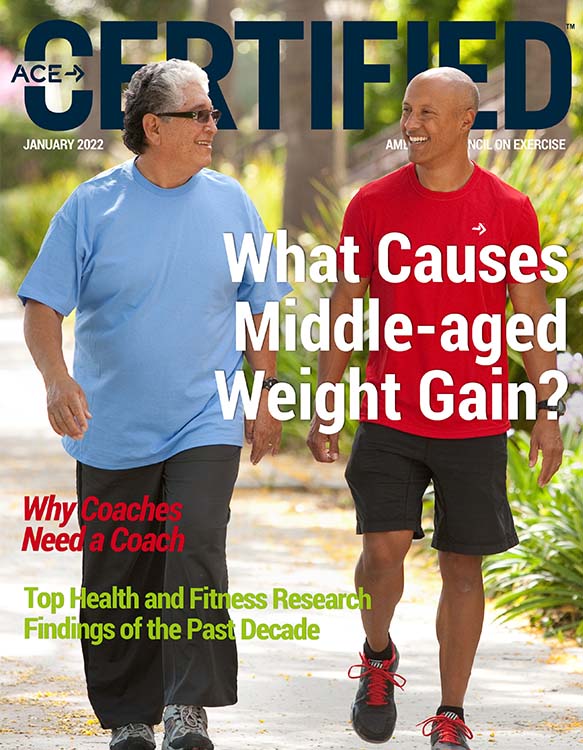
No single piece of research can offer “proof” of anything or serve as the definitive statement on a particular topic. That said, on occasion a study is published that can make us pause and think about something in a new way. Here, we’ve asked five of ACE’s leading subject matter experts to identify a piece of research that they think all ACE Certified Professionals should know about, explain why they find it so intriguing and explore how it might change the day-to-day practice of health coaches or exercise professionals.
What You Need to Know
- Being physically active is more important to overall health than weight loss. Help clients understand that if they can implement healthy lifestyle changes over the long haul and let whatever weight-related outcomes be what they are, they will be far better off from a health standpoint and from a functional capability standpoint.
- One type of exercise program does not work for everyone. Every individual will respond uniquely to the types of exercise to which they are exposed based on their individual genetics.
- Bouts of physical activity that are less than 10 minutes in duration lead to improved health outcomes, and participating in moderate-to-vigorous physical activity of any length can have a health-enhancing effect.
- Wearable technology can empower clients, provide an avenue of facilitated learning about their health journey and support them through accountability, while enhancing their feelings of confidence and assurance.
- While occupation-related energy expenditure has decreased over the past several decades, implementing creative ways to increase energy expenditure can reverse the damaging impact of a more physically inactive work force.
Which is More Important for Reducing Health Risks: Losing Weight or Improving Fitness?

Cedric X. Bryant, PhD, FACSM, is the President and Chief Science Officer of the American Council on Exercise. Dr. Bryant shares his expertise by serving on the advisory boards and committees for several highly respected public health organizations, including the World Health Organization, Centers for Disease Control and Prevention, and National Academy of Sciences, Engineering and Medicine.
Obesity Treatment: Weight Loss Versus Increasing Fitness and Physical Activity for Reducing Health Risks
This research found that the mortality risk associated with obesity is largely attenuated or eliminated by moderate-to-high levels of cardiorespiratory fitness or physical activity and that most cardiometabolic risk markers associated with obesity can be improved through exercise even without weight loss. In fact, weight loss is not consistently associated with a reduced mortality risk, while weight cycling is associated with numerous adverse health outcomes, including increased mortality. For this reason, the researchers propose a weight-neutral strategy for obesity treatment, emphasizing the fact that adherence to physical activity may improve if the focus is shifted away from the pursuit of weight loss and toward becoming more physically active and improving one’s cardiorespiratory fitness.
- What is it about this research that you find so compelling or intriguing?
There is such an unhealthy obsession with weight loss to begin with, and, if you look at it from a health perspective, we sometimes overvalue its impact on overall health, particularly when you think in terms of outcomes related to cardiometabolic diseases. What I like about this study is that it strongly suggests that the focus should shift more toward helping people adopt and maintain healthier lifestyles, with physical activity being a major component of those lifestyle changes.
- What is the key take-away message that you want health coaches and exercise professionals to understand?
For health coaches and exercise professionals, the recommendations stemming from this study should be music to their ears. This study suggests that they should shift the conversation when working with their clients away from one that’s so weight-centric to one that’s more healthy lifestyle–centric. The idea is to help people understand that if they can implement healthy lifestyle changes over the long haul and let whatever weight-related outcomes be what they are, they will be far better off from a health standpoint and from a functional capability standpoint. To me, that’s going to translate into a much higher quality of life.
- How might the findings impact the work of health coaches or exercise professionals?
It’s a new way to talk to people and a way to reframe the collaborative discussion around goal setting. Being so singularly focused on weight loss typically does not help people achieve a better quality of life and can lead to a lot of unhealthy and unnecessary frustration because what we can achieve from a weight standpoint is going to be limited by our genetics and other factors, many of which are beyond our control or direct influence. Also, a lot of times, people follow relatively unhealthy practices to achieve unrealistic amounts of weight loss that are probably not within their capabilities to sustain. That’s why so many people lose a lot of weight and regain it repeatedly, and these unsustainable changes are setting them up for frustration and a lack of success over the long term. If health coaches and exercise professionals deemphasize trying to lose a certain amount of weight and instead focus on how clients can adopt lifestyle practices that fit into who they are and what’s important to them, that can lead to much more meaningful and sustainable success.
Do Our Genes Determine How We Respond to Exercise?

Sabrena Jo, M.S., ACE’s Senior Director of Science and Research and ACE Liaison to the Scientific Advisory Panel, has been actively involved in the fitness industry since 1987. As an ACE Certified Group Fitness Instructor, Personal Trainer, and Health Coach, she has taught group exercise and owned her own personal-training and health-coaching businesses.
Do Exercise-associated Genes Explain Phenotypic Variance in the Three Components of Fitness? A Systematic Review & Meta-analysis
This research involved a large-scale meta-analysis of 24 studies that included more than 3,000 participants. The aim was to identify a list of genes associated with three components of fitness—cardiovascular fitness, muscular strength and anaerobic power—and how these genes are associated with the response to exercise in previously untrained individuals. What the researchers found was that genetic variability explained a significant proportion of the response to exercise across all three components.
- What is it about this research that you find so compelling or intriguing?
It’s intriguing because this research provides more evidence to support the notion that each of us will respond uniquely to the types of exercise to which we are exposed. For far too long, I think exercise professionals have given clients programs for increasing muscle mass, weight loss, etc., and expected “textbook” results if the clients followed the program. The main point here is that we have much less control over the outcomes of program design than many exercise professionals may believe, and this is due to our individual genetics.
- What is the key take-away message that you want health coaches and exercise professionals to understand?
The take-home message here is that our unique gene expression makes us one of a kind, so we shouldn’t get hung up on comparing ourselves to others. Regular exercise improves health and fitness, and we don’t have complete control over how our bodies will respond.
- How might the findings impact the work of health coaches or exercise professionals?
The findings open us up to enjoying movement more, while focusing less on the outcomes. Findi ng ways to incorporate physical activity into our lifestyles, whether it’s in the form of structured exercise or spending less time sitting, should be a function of how well it suits our values and preferences and less about appearance or performance outcomes. Health coaches and exercise professionals should feel confident promoting the concept that improved health will result from consistent participation in physical activity, regardless of our genetics.
Are Brief Bouts of Exercise Effective for Improving Health?

Chris Gagliardi, ACE’s Scientific Education Content Manager, is an ACE Certified Personal Trainer, Health Coach, Group Fitness Instructor and Medical Exercise Specialist.
Association between Bout Duration of Physical Activity and Health: Systemic Review
The goal of this meta-analysis was to determine whether exercise bouts need to last at least 10 minutes to yield meaningful benefits. The current evidence supports the idea that physical activity of any duration is associated with improved health outcomes, including all-cause mortality.
- What is it about this research that you find so compelling or intriguing?
What I find interesting about the research evaluated in this systemic review is that it challenges the long-standing belief that bouts of physical activity need to take place in episodes of at least 10 minutes for health benefits to occur.
- What is the key take-away message that you want health coaches and exercise professionals to understand?
The key take-away is that yes, bouts of physical activity of 10 minutes and longer do lead to improved health outcomes, but so do bouts of physical activity that are less than 10 minutes in duration. In fact, participating in moderate to vigorous physical activity of any length can have a health-enhancing effect.
- How might the findings impact the work of health coaches or exercise professionals?
The findings are important for health coaches and exercise professionals because they make it easier to meet people where they are on the journey toward leading a healthier life. Many people believe there is no point to being active unless you can do so for hours at a time because they believe that is how you get healthier. That way of thinking, paired with the perception of not having enough time for exercise, is a recipe for not acting. Imagine instead a scenario where you can ask a client, “How much time do you have?” when discussing being active. No matter what answer they give—30 seconds, 1 minute, 3 minutes or 5 minutes—this can serve as a great starting point for building initial success and self-efficacy.
Can Wearable Technology Help Clients Achieve Their Goals?

Ted Vickey, PhD, is a member of ACE’s Scientific Advisory Panel and the Founder & President of FitWell, Inc. He is also a professor at Point Loma Nazarene University in the Master’s program in the School of Kinesiology.
“Wearables Only Work on Patients That Wear Them”: Barriers and Facilitators to the Adoption of Wearable Cardiac Monitoring Technologies
The researchers conducted a meta-analysis in an effort (1) to explore the perceptions and experiences of older adults and health professionals about using wearable cardiac monitoring technologies and (2) to identify barriers and facilitators of acceptance and uptake of these devices in clinical practice. What they found was that there are many barriers and facilitators to the adoption of wearable devices, including those related to the design of the devices, appropriate and timely feedback, user-friendly technology and affordability and cost.
- What is it about this research that you find so compelling or intriguing?
This article is from researchers with interests in cardiac monitoring within healthcare. I believe we in the fitness industry can learn from their findings, as well. As mentioned in the article title, “wearables only work on patients that wear them.” I often hear this as a reason for a personal trainer or health coach to not use wearables with their clients, but the reasoning is flawed. The article suggests that poor instruction or a lack of help regarding wearable use are reported barriers or factors related to abandonment or discontinuation of the wearable. A wellness professional who incorporates said instruction and provides help on continued usage of the wearable would counteract two of the barriers of use.
- What is the key take-away message that you want health coaches and exercise professionals to understand?
Other research has suggested that wearables and other “disruptive health technologies,” or DHTs, when combined with the experience of a health coach or exercise professional, are more successful in terms of health outcomes when compared to the use of the DHT alone. Wearables can empower clients, provide an avenue of facilitated learning about their health journey and support them through accountability, while enhancing their feelings of confidence and assurance.
- How might the findings impact the work of health coaches or exercise professionals?
The use of collected wellness data from a DHT source allows a health coach or exercise professional to create a unique and personalized wellness plan that is based on actual data. That success comes from the health coach or exercise professional being able to collect the DHT data from the client, convert it into actionable data, create a wellness plan based on the collected and converted data, and then communicate the personalized data-driven wellness plan to the client. I call this a data-driven personal-training plan, a plan that shifts the personal-training model from the old way of training, from where a trainer’s time is traded for a client’s money, to Personal Training 3.0, where a trainer is effectively using technology to collect, convert, create and communicate a detailed and personalized wellness plan with their clients. This is a model that not only works smarter, not harder, but also allows the professional to create additional value that should elicit an increase in the prices they can charge clients.
There is a misconception that these technologies are the “magic pill” and that using them will solve many of our clients’ challenges. They are not. They are simply another tool (albeit a powerful one) that a health coach or exercise professional can use with their clients along their journey toward better health.
How Has the Way We Work Changed How Much We Move?

Lance C. Dalleck, PhD, is a member of ACE’s Scientific Advisory Panel and serves as a professor of exercise and sport science at Western Colorado University in Gunnison, Colo.
Trends Over 5 Decades in U.S. Occupation-Related Physical Activity and Their Associations with Obesity
The objective of this analysis was to examine trends in occupational physical activity and explore how they relate to changes in body weight in the United States over that same period. For example, in the early 1960s, almost half the jobs in private industry in the U.S. required at least moderate-intensity physical activity; now, less than 20% of jobs demand this level of energy expenditure. What the researchers found was that between 1960 and 2010, daily occupation-related energy expenditure decreased by more than 100 calories, and this reduction accounts for a significant portion of the increase in mean body weight in the U.S.
- What is it about this research that you find so compelling or intriguing?
As the authors explain, their findings provide a good explanation for the weight gain we have observed in the U.S. over the past decades. And these findings make sense, as we know technological advances have made our lives easier (at both home and work). I think what is particularly intriguing is the insidious nature of the reduced occupational daily energy expenditure and how it contributes to obesity.
- What is the key take-away message that you want health coaches and exercise professionals to understand?
The caloric numbers (124 for women and 140 for men) the authors identify are not necessarily eye popping, as these energy expenditure values are easily achieved with 20 to 30 minutes of moderate-intensity exercise. Furthermore, these reductions occurred over five decades, so in any given year the decrease in occupational energy expenditure was only 2 or 3 calories per day! The key take-away message for health coaches and exercise professionals is that small reductions in energy expenditure over a prolonged period of time can have a substantial impact on overweight/obesity and a myriad of comorbidities (i.e., it’s insidious!).
- How might the findings impact the work of health coaches or exercise professionals?
The silver lining is that the opposite holds true—identifying creative ways over the long-term to increase energy expenditure can reverse the above-described damaging health patterns. In particular, I think it’s critical that health coaches and exercise professionals educate clients that small adjustments to daily behaviors and/or exercise habits are super important. For example, I get really excited about findings such as what we just published in CERTIFIED that show increased excess post-exercise oxygen consumption (EPOC) energy expenditure with personalized reduced-exertion high-intensity interval training (REHIT). The fact that clients can perform a short 15-minute CAROL workout over lunch and then return to work with ongoing EPOC that contributes to a much greater overall energy expenditure than traditional moderate- or vigorous-intensity workouts means, in the context of the study above, that we have substantially narrowed that 100 to 140 calorie gap in reduced daily occupational energy expenditure that has transpired over the past 50 or 60 years. That is exciting! And it’s up to us as health coaches and exercise professionals to assist our clients in making these important connections.
In Conclusion
The research conducted over the past decade has profoundly contributed to our current understanding of a wide breadth of topics. The five areas emphasized in these studies have helped exercise professionals and health coaches to reflect and pivot in a meaningful way to better serve their clients. Increasing fitness may be more important than weight loss, we don’t have complete control of how our bodies respond to exercise, any amount of physical activity beyond what you normally do can lead to health benefits, wearable technology works, and client instruction is essential for use, and implementing creative ways to increase energy expenditure can reverse the damaging impact of a more physically inactive work force. These are powerful messages that, when shared with clients and colleagues, can help shape the way we think, collaborate, design exercise programs and support lasting behavioral change.





 by
by 







